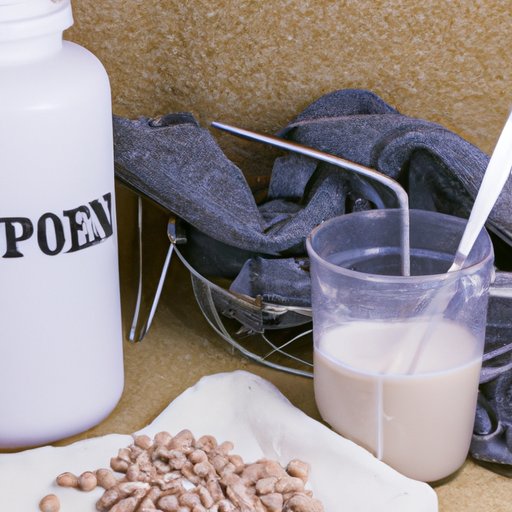
I. Introduction
If you are looking to shed some pounds, you may be wondering how much protein you need to consume to achieve your weight loss goals. Protein is an essential nutrient that not only helps to repair and build muscle but also keeps you feeling full and satisfied, preventing overeating. In this article, we will explore the science behind protein and weight loss and help you determine your optimal protein intake for successful weight loss.
II. The Science of Protein: Understanding Its Role in Weight Loss
Protein is essential for weight loss because it has a high satiety value, which means it keeps you feeling full and satisfied for longer. This can prevent overeating and snacking between meals, leading to fewer calories consumed overall. Additionally, protein has a higher thermic effect on the body than carbohydrates and fats, which means that it requires more energy to digest and absorb, resulting in more calories burned.
It is important to consume high-quality protein sources such as lean meats, fish, poultry, eggs, dairy, beans, and nuts to ensure you are getting the full benefits of protein without added unhealthy fats or sugars.
III. How to Determine Your Optimal Protein Intake for Weight Loss
There are several factors that influence your optimal protein intake, including age, gender, weight, and activity level. The general recommendation from health authorities is to consume at least 0.36 grams of protein per pound of body weight per day. However, if you are physically active or looking to build muscle, you may need to increase this amount.
There are several online tools and formulas available to help you calculate your protein needs, including the Harris-Benedict equation and the Katch-McArdle formula. It is also important to track your protein intake, especially if you are trying to lose weight.
IV. Top Protein Sources for Effective Weight Loss
Some examples of high-protein foods include:
- Chicken breast
- Tuna
- Salmon
- Eggs
- Low-fat cheese
- Almonds
- Beans and legumes
- Greek yogurt
It is important to vary your protein sources to ensure you are getting a wide range of important nutrients. Additionally, be aware of the nutritional values of different protein sources and choose high-quality, low-fat options whenever possible.

V. Protein Shake Recipes for Weight Loss and Muscle Tone
Protein shakes can be a convenient and easy way to consume high-quality protein. They are especially beneficial for weight loss because they are low in calories and can be used as a meal replacement.
Some examples of protein shake recipes include:
- Chocolate protein shake: 1 scoop chocolate protein powder, 1 cup unsweetened almond milk, 1/2 banana, and ice
- Berry protein smoothie: 1 scoop vanilla protein powder, 1 cup mixed berries, 1/2 cup unsweetened vanilla almond milk, and ice
- Peanut butter banana protein shake: 1 scoop vanilla protein powder, 1/2 banana, 1 tablespoon peanut butter, 1 cup unsweetened almond milk, and ice
When selecting a protein powder, look for one that is low in sugar and high in protein. Some popular options include whey, casein, and plant-based protein powders such as pea or hemp protein.
VI. Combining Protein with Exercise for Maximum Weight Loss Results
Exercise is crucial for successful weight loss, and combining it with protein can help maximize results. Resistance training, such as weight lifting or bodyweight exercises, can help build muscle mass and increase metabolism, leading to more calories burned overall.
Some examples of exercises that combine protein and resistance training include:
- Chicken and veggie stir fry with brown rice
- Grilled salmon with roasted asparagus
- Quinoa and black bean salad with grilled chicken
VII. High-Protein Meal Plans for Weight Loss Success
High-protein diets, such as the Atkins, Paleo, and Keto diets, are popular for weight loss because they can help keep you feeling full and satisfied while also promoting muscle growth. However, it is important to be aware of the risks associated with these diets, such as potential nutrient deficiencies.
Some recommendations for incorporating protein into meals throughout the day include:
- Having eggs for breakfast
- Using nut butters or low-fat cheese as a snack
- Incorporating lean meats, fish, or beans into lunches and dinners
Here are some high-protein meal plans to help get you started:
- Day 1:
- Breakfast: Spinach and feta omelet with whole-grain toast
- Lunch: Grilled chicken salad with mixed greens, tomatoes, and avocado
- Dinner: Baked salmon with roasted veggies and quinoa
- Day 2:
- Breakfast: Greek yogurt with mixed berries and almonds
- Lunch: Turkey and hummus wrap with carrots and cucumber sticks
- Dinner: Chili con carne with black beans and brown rice
- Day 3:
- Breakfast: Peanut butter banana protein shake
- Lunch: Grilled shrimp and quinoa salad with mixed greens and veggies
- Dinner: Beef stir fry with broccoli and brown rice
VIII. Common Mistakes to Avoid When Consuming Protein for Weight Loss
One common mistake when trying to consume more protein is overconsumption. Consuming excessive amounts of protein can lead to weight gain and may also put an unnecessary strain on your kidneys.
Additionally, some high-protein foods may hinder weight loss efforts, such as processed meats and high-fat dairy products. It is important to balance your diet with a healthy variety of fruits, vegetables, whole grains, and healthy fats.
IX. Conclusion
Consuming an optimal amount of protein is vital for weight loss success. By understanding the science of protein and how to calculate your protein needs, incorporating high-quality protein sources into your diet, and combining protein with exercise and resistance training, you can achieve your weight loss goals. Remember to make informed choices and strive for balance in your diet to ensure long-term success.





